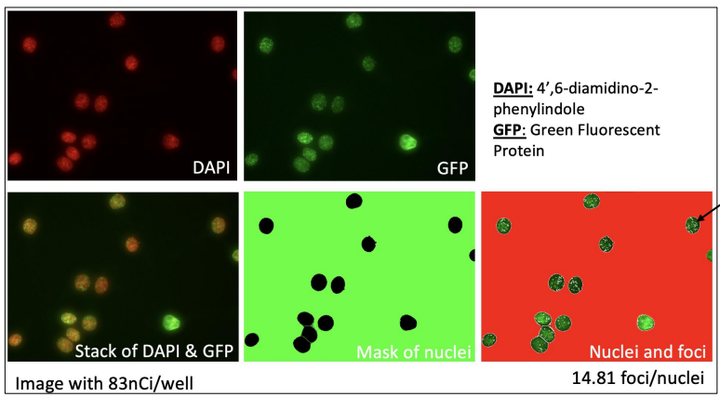Validation of Monte Carlo Simulations to Assess DNA Damage from 225Ac for Radiopharmaceutical Therapy
 Figure: Nuclear and DNA damage staining using DAPI and GFP
Figure: Nuclear and DNA damage staining using DAPI and GFP
Abstract
Purpose: We previously developed a multiscale Monte Carlo framework to assess radiation effects in radiopharmaceutical therapies. This work focuses on validation of the simulation in assessing DNA damage through a cell culture experiment using 225Ac, an alpha-emitter for targeted therapy.
Methods: In a cell culture experiment, mouse breast cancer (E0771) cells were exposed to eight different activities of 225Ac: 2.4(±3.0%), 5.3(±3.9%), 11.8(±2.6%), 18.9(±2.1%), 41.5(±2.4%), 83.0(±1.8%), 175.1(±1.4%), and 345.2(±1.5.0%) nCi/well over 24 hours. The activity of 225Ac was measured with HPGe detectors. Cells were seeded at a density of 3000 cells/well. After exposure, excess activity was removed using phosphate-buffered saline, and DNA damage was estimated through 𝛾-H2AX immunofluorescent staining. The experimental setup was closely replicated using Geant4 and TOPAS-nBio to simulate the phase space of particles entering the cellular volume and estimate double-strand breaks (DSBs). The simulated cells were modeled as spheres with a nuclear diameter of ~10 µm and were randomly distributed in cell well. DNA DSBs were estimated by randomly selecting 100 cells from different cell wells and comparing the simulated results with corresponding physical estimates.
Results: For the eight activities, we obtained the following experimental estimates for DNA damage: 2.1±0.4, 3.5±0.4, 5.5±1.2, 8.9±0.9, 11.1±1.5, 14.8±1.5, 15.1±3.9, and 15.3±1.4 foci/nuclei. Monte Carlo simulations predicted 2.3, 4.7, 7.5, and 11.6 DSBs/nuclei with 2.4, 5.3, 11.8, and 18.9 nCi/well. Uncertainty in experimental measurement in HPGe was <4%, and simulation uncertainties were within 6%. The dose-response curve was linear at low activity, and saturation occurred at higher levels. Monte Carlo estimations were within ±24% compared to measurements at low doses up to 18.9 nCi/well.
Conclusion: We validated our Monte Carlo simulation in assessing DNA damage from different 225Ac activity levels. The validated simulation can serve as a tool to assess the efficacy of various cancer therapeutic applications, including targeted alpha therapies.